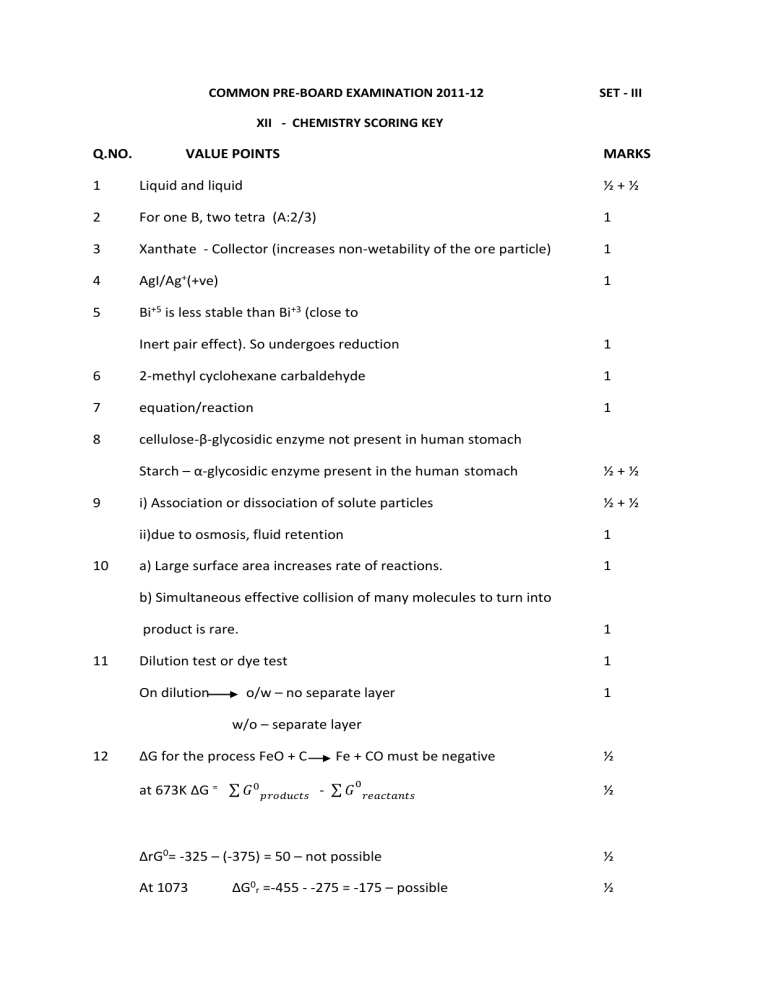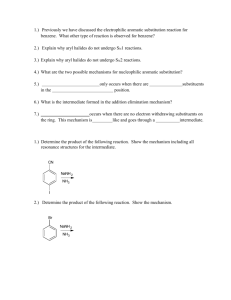ChemistryAK - kvafsavadistaff

3
4
5
COMMON PRE-BOARD EXAMINATION 2011-12 SET - III
XII - CHEMISTRY SCORING KEY
Q.NO.
1
VALUE POINTS
Liquid and liquid
2 For one B, two tetra (A:2/3)
MARKS
½ + ½
1
Xanthate - Collector (increases non-wetability of the ore particle)
AgI/Ag + (+ve)
Bi +5 is less stable than Bi +3 (close to
1
1
1
1
1 7
8
6
9
10
Inert pair effect). So undergoes reduction
2-methyl cyclohexane carbaldehyde equation/reaction cellulose-β-glycosidic enzyme not present in human stomach
Starch – α-glycosidic enzyme present in the human stomach i) Association or dissociation of solute particles ii)due to osmosis, fluid retention a) Large surface area increases rate of reactions.
On dilution o/w – no separate layer w/o – separate layer
12 ΔG for the process FeO + C Fe + CO must be negative at 673K ΔG = ∑ 𝐺 0 𝑝𝑟𝑜𝑑𝑢𝑐𝑡𝑠
- ∑ 𝐺
0 𝑟𝑒𝑎𝑐𝑡𝑎𝑛𝑡𝑠
ΔrG 0 = -325 – (-375) = 50 – not possible
At 1073 ΔG 0 r
=-455 - -275 = -175 – possible b) Simultaneous effective collision of many molecules to turn into
product is rare.
11 Dilution test or dye test
½ + ½
½ + ½
1
1
1
1
1
½
½
½
½
13 i) S is sterically protected in SF
6 ii) reacts with atmospheric oxygen to form reddish brown NO
2
.
Or eqn. NO + 1/2O
2
NO
2
14 HCl gets oxidised to Cl
2
by KMnO
4 but H
2
SO
4 does not react
16HCl + 2KMnO
4
5 KCl + 2MnCl
2
+ 5Cl
2
+8H
2
O
Or
A = Dichromate ion Cr
2
O
7
2-
B =Chromate ion CrO
4
2-
CrO
4
2-
H+
Cr
2
O
7
2-
OH -
[ 2CrO
4
2 + 2H + Cr
2
O
7
2+ H
2
O
Cr
2
O
7
2 + OH 2CrO
4
2 + H
2
O ]
15 (i)C
6
H
5
CH(C
6
H
5
)Br due to the higher stability of carbocation formed
(ii)CH
2
=CH-CH
2
I weaker -CI bond
1
1
16 (i) To prevent the formation of toxic phosgene
(carboyl chloride) or correct equation
(ii) Any one reason
CHCl
3
/ NaOH
17 (i) C
6
H
5
OH
Reimer – Tiemann reaction
Ortho and para hydroxy benzaldehyde
½
(ii) C
6
H
5
-OCH
3
CH
3
Cl/ anhyd. AlCl
3
C
6
H
4
(OCH
3
)CH
3
(Ortho and para)
Friedel – crafts alkylation
½
½
1
1
1
1
1
1
1
1/2
1/2
18 (i) propene i.
B
2
H
6 ii. H
2
O
2
/OH -
propan-1-ol
Or
HBr
Propene 1-bromopropane
H
2
O
2
(ii)ethanol
SOCl
2
C
2
H
5
Cl
NaOH
propan-1-ol
Na-CΞCH/ ether
C
2
H
5
-CΞCH
1
1
but-1-yne
𝑍𝑀
19 d:
𝑁
𝐴 𝑎 3
½
For FCC: z=4 ½
Substituting correct values 1/2 agrees with measured value
8.97 gm/cm 3
20 ΔH = -ve
-ve deviation
Labelled graph
One example
21 first order reaction
1
1
½
1
1
½ t=
2.303
𝐾 𝑙𝑜𝑔 𝑎 𝑎−𝑥 or t=
2 .
303 log
K
[ R
0
]
[ R ]
½
K=
0.693
𝑡
1
⁄
2
½
0.693
K =
37.9 secs
= 0.0183 s -1 ½
Substitution with correct values 1/2
Correct answer with unit(time) = 75.77 sec. ½
22 (i) H
2
O is a weak ligand. Thus d 7 is stable. With strong ligands, more
CFSE which compensate 3 rd I.E
(ii) High hydration enthalpy of Cu 2+ compensate second I.E value
(iii) Similar size due to intervening lanthanide contraction
23 differentiation – (definition, difference)
Phenol
24 i. Correct, labelled diagram for octahedral co-ordn. No.6; octahedral complex ii. t
2g
4 , e g
0 ½ iii. optical 1/2
25 (i) more p kb means less kb, hence aniline is less basic than ethyl amine.
Non-availability of L.P of electrons of N in aniline due to –R effect of
benzene ring. Or +I effect of alkyl group in ethyl amine increases
availability of electrons
(ii) 3 0 amines do not have an H for displacement on nitrogen atom
1
1
1
1
1
2
1
1 1/2
(iii) Zwitter ion (in neutral) medium is least soluble (in water).
In acids and bases, become soluble form.
26 initiation peroxide +ethene
Propagating step
Terminating step
Or
Caprolactum and water at high temperature – Nylon 6 (correct equation) 2
1
1
1
1
A 6 carbon starting monomer
27 (i) essential amino acids
(ii) Glycogen
(iii) B
12
1
1
1
1
28 (i) Statement and explanation of Kohlrausch’s law
(ii) ΔG 0 = -nFE 0 cell
; substitution and correct answer 45548 KJm -1
Log kc = 𝑛𝐸
0 𝑐𝑒𝑙𝑙
; substitution and correct answer
0.059
Log kc = 8.00 k c
= 1x10 8
1+1
1 ½
1 ½
Or
(i) Fuel cell definition 1
Anode and cathode reactions ½ + ½
(ii) E cell
= E 0 cell
–
0.059
2 𝑙𝑜𝑔
[𝐹𝑒
2+
]
[𝐻 + ] 2
1
Oxidation reaction Fe Fe 2+ + 2e -
Reduction reaction 2H + + 2e - H
2
½ + ½
1 EMF calculation and correct answer 0.5185V
29. CH
3
Br+Mg CH
3
MgBr
O C O +CH
3
MgBr O = COMgBr
CH
3
O O
P/Cl
2
ClCH
2
C OH CH
3
C OH
H
2
O H
3
O +
NH
2
CH
2
COOH
O
A=CH
3
MgBr ; B=CH
3
C OMgBr
O
C=CH
3
C OH D= ClCH
2
C OH
E = NH
2
CH
2
COOH
OR
2 ½
2 ½
Kolbe’s electrolysis
[O]
C
5
H
10
O C
3
H
6
O
2
C ½
Arrival of formula by positive 2,4 DNP test and negative iodoform and Tollen’s test.
CH
3
CH
2
COCH
2
CH
3
[O] CH
3
CH
2
COOH
CH
3
CH
2
COONa Kolbe’s electrolysis CH
3
CH
2
CH
2
CH
3
A - CH
3
CH
2
COCH
2
CH
3
B - CH
3
CH
2
COOH C - CH
3
CH
2
CH
2
CH
3
1
1
1
1 1/2
30. A=Sulphur
C=SO
2
(g)
B=H
2
S gas
D=SO
3
gas
Reactions are
MnO
4
+ 8H + +5e → Mn 2+ + 4H
2
O X 2
SO
2
+ 2H
2
O→ SO
4
2+4H + +2e X 5
2MnO
4
+5 SO
2
+2H
2
O → 2Mn 4 +5 SO
4
2+4H +
V
2
O
5
(S)
2SO
2(S)
+ O
2(S)
→ 2SO
3(g)
[OR] a) i)XeF
4
+PF
5
→ [XeF
3
] + [PF
6
] - ii)U+3 ClF
3
→ UF
6
+3ClF iii)Ca
3
P
2
+ 6H
2
O →3Ca(OH)
2
+2PH
3 b) c) i) Correct Structure ii)Correct Structure
2
3
3
1
1






